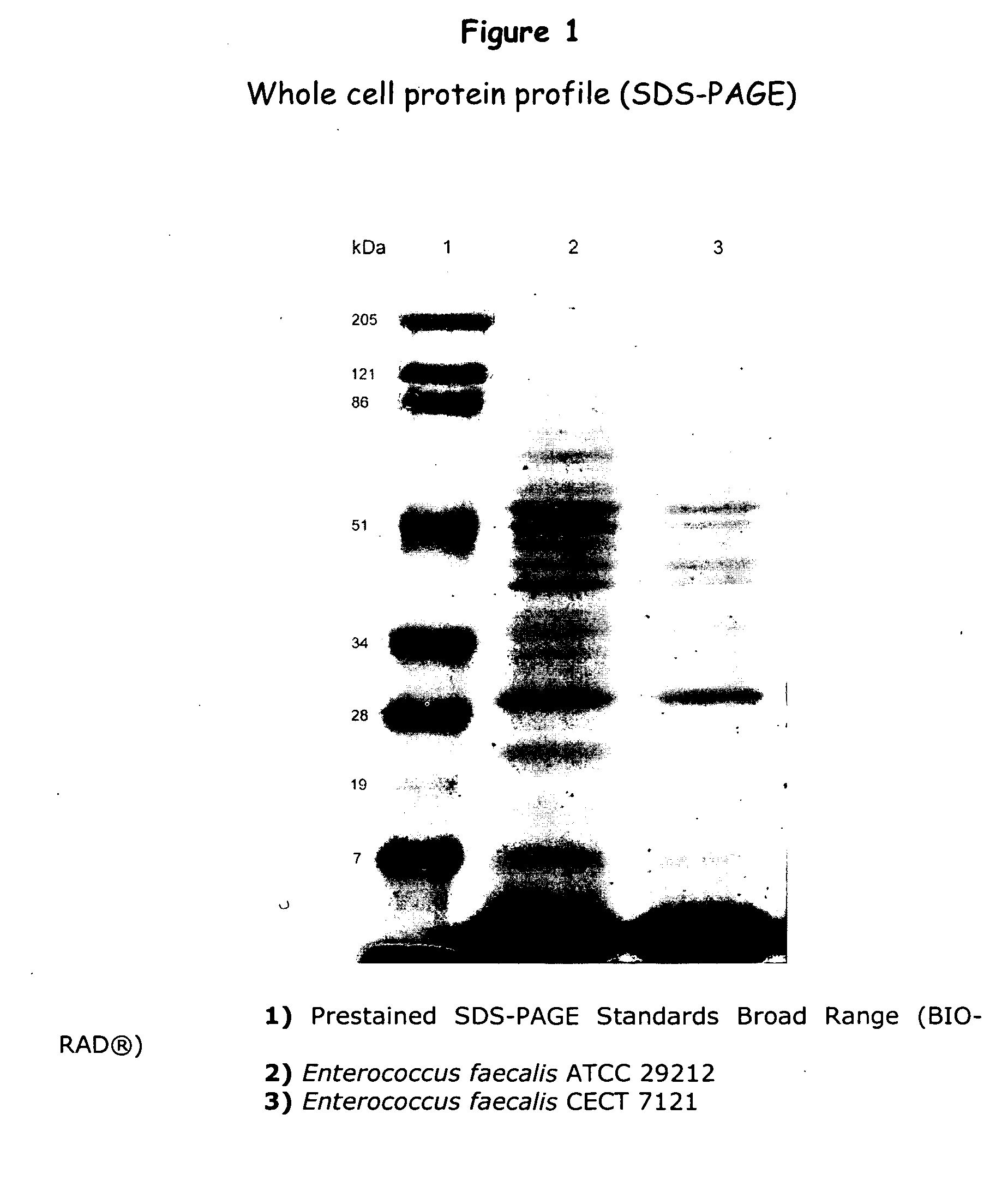New lactic bacteria useful as probiotics
a technology of lactic bacteria and probiotics, applied in the field of pathogen ingestion, can solve the problems of harmful effects, diarrhea, weight loss, and common problem of pathogens, and achieve the effects of reducing the number of bacteria, preventing the growth of new bacteria, and improving the survival rate of bacteria
- Summary
- Abstract
- Description
- Claims
- Application Information
AI Technical Summary
Benefits of technology
Problems solved by technology
Method used
Image
Examples
example i
[0075] Biochemical Characterization of Enterococcus faecalis GALT
[0076] a) Hemolytic Activity
[0077] The study of hemolytic activity of E. faecalis GALT was carried out using human (all four blood types), ram and horse red blood cells. A E. faecalis GALT culture of 18 h in brain-heart infusion was used for isolations on base agar Columbia supplemented with blood of different origin (5%, v / v). Plaques were incubated under anaerobic conditions (Gas-Pack system) at 35° C., and monitored for 24 h and 72 h after incubation. Surrounding the colonies, the presence of a clear zone of hydrolysis (β hemolysis), partial action (α hemolysis) or absence of hemolytic activity (γ hemolysis) were analyzed. The strain E. faecalis GALT did not hydrolyze red blood cells of different origin (γ hemolysis) which is why there is no production of hemolysins.
[0078] b) Production of Gelatinase
[0079] The production of gelatinase by E. faecalis GALT was determined by addition of mercurial chloride to a cult...
example ii
In Vitro Antibacterial Activity of E. faecalis GALT
[0113] Screening for inhibitory activity was carried out using a modified version of the “double layer technique” (Tagg et al., 1975). E. faecalis GALT cultures were assayed after 18 h incubation in brain-heart infusion. Plates with brain-heart, previously inoculated with 5 μl of material, were incubated under anaerobic conditions (24 h at 30° C.). Then, each plate was covered with 7 ml soft agar (7 g / L) inoculated with 0.1 ml of the indicator strain (about 107 UFC / ml). Plates were incubated during 18 h, under aerobic or anaerobic conditions, according to the requirements of the indicator strain.
[0114] The strain E. faecalis GALT showed in vitro inhibitory activity against Gram-positive bacteria: Listeria monocytogenes, Staphylococcus aureus, Streptococcus pneumoniae, E. faecium, E. durans, E. gallinarum-casseliflavus, Str. agalactiae, Str. dysgalactiae, Str. uberis, Clostridium perfringens, C. sporogenes, Bacillus subtilis, and ...
example iii
[0115] Bactericidal Effect of E. faecalis GALT on L. monocytogenes in Goat Milk
[0116] In order to analyze the effect of this strain on deteriorating or pathogenic bacteria present in milk, the inhibitory activity on the pathogen L. monocytogenes resistant to environmental conditions was used as a model.
[0117] The inhibitory ability of E. faecalis GALT was investigated when competing with autochthonous bacteria of goat milk, against L. monocytogenes CEB 101 and L. monocytogenes ATCC 49594 (derived from the strain Scott A, which in studies carried out by other authors in milk and cheese, showed higher resistance to the inhibitory action of enterocin-producing strains). The system employed in the research excluded the influence of other inhibitory factors such as very acid pH and hydrogen peroxide.
[0118] For the production of the inhibitory component, a culture incubated 18 h at 35° C. of E. faecalis GALT in brain-heart infusion was centrifuged at 10,000×g during 10 min and suspende...
PUM
| Property | Measurement | Unit |
|---|---|---|
| molecular mass | aaaaa | aaaaa |
| weights | aaaaa | aaaaa |
| pH | aaaaa | aaaaa |
Abstract
Description
Claims
Application Information
 Login to View More
Login to View More - R&D
- Intellectual Property
- Life Sciences
- Materials
- Tech Scout
- Unparalleled Data Quality
- Higher Quality Content
- 60% Fewer Hallucinations
Browse by: Latest US Patents, China's latest patents, Technical Efficacy Thesaurus, Application Domain, Technology Topic, Popular Technical Reports.
© 2025 PatSnap. All rights reserved.Legal|Privacy policy|Modern Slavery Act Transparency Statement|Sitemap|About US| Contact US: help@patsnap.com


